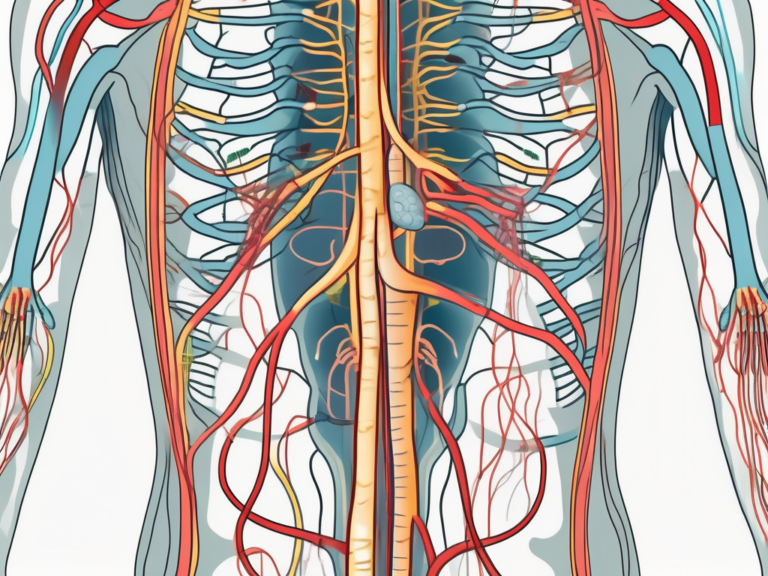The Role of the Olfactory Nerve in Smell Detection
The olfactory nerve, also known as the first cranial nerve, plays a crucial role in our ability to detect and perceive smells. Understanding the intricacies of the olfactory system and how this nerve functions can provide valuable insights into the fascinating world of smell.
Understanding the Olfactory System
The olfactory system is responsible for our sense of smell, one of the most powerful and evocative senses we possess. It allows us to detect a wide range of odors, from the pleasant aroma of freshly brewed coffee to the pungent scent of rotten eggs. The olfactory system comprises various structures, with the olfactory nerve acting as a vital link in the chain.
Anatomy of the Olfactory System
The olfactory system consists of several key components, including the olfactory epithelium, olfactory nerve, olfactory bulb, and olfactory cortex. The olfactory epithelium, located in the upper part of the nasal cavity, contains millions of specialized sensory receptors called olfactory receptor neurons. These neurons have hair-like structures called cilia that extend into the nasal cavity, where they come into contact with airborne odorant molecules.
But what happens once these odorant molecules come into contact with the cilia of the olfactory receptor neurons? Well, that’s where the olfactory nerve comes into play. Comprised of bundles of axons from olfactory receptor neurons, the olfactory nerve acts as a messenger, transmitting signals from the olfactory epithelium to the olfactory bulb, which is located at the base of the brain.
Now, let’s take a closer look at the olfactory bulb. This small but mighty structure is responsible for processing the incoming signals from the olfactory nerve. It’s like the brain’s very own “scent laboratory.” In the olfactory bulb, the signals undergo complex processing, allowing for the extraction of valuable information about the odorant stimulus. It’s here that the brain begins to make sense of the smells we encounter in our daily lives.
The Olfactory Process: From Nose to Brain
The olfactory process begins when odorant molecules bind to specific odorant receptors on the cilia of olfactory receptor neurons. This binding triggers a chain reaction, resulting in the generation of electrical signals. These signals then travel along the axons of the olfactory nerve to reach the olfactory bulb.
Once the signals reach the olfactory bulb, they embark on a fascinating journey of interpretation and analysis. The olfactory bulb acts as a relay station, where the incoming signals are sorted, organized, and transformed into a language that the brain can understand. It’s like a bustling hub of activity, with different regions specialized in different aspects of smell processing.
From the olfactory bulb, the information is transmitted to the olfactory cortex, a region of the brain dedicated to the perception of smell. Here, further analysis takes place, as the brain tries to make sense of the odorant stimulus. It’s in the olfactory cortex that we experience the conscious perception of smell, where the aroma of a rose or the stench of a skunk becomes a vivid sensory experience.
The Olfactory Nerve: A Closer Look
Structure and Function of the Olfactory Nerve
The olfactory nerve, often referred to as cranial nerve I, is a fascinating bundle of sensory axons that extends from the olfactory epithelium to the olfactory bulb. These axons form a pathway for the transmission of odorant signals from the nasal cavity to the brain. Structurally, the olfactory nerve is unique, as it is the only cranial nerve that directly connects the sensory receptors to the central nervous system.
But what exactly happens along this intricate pathway? Let’s delve deeper into the structure and function of the olfactory nerve to gain a better understanding.
The function of the olfactory nerve is crucial in ensuring the swift and accurate transmission of odorant information from the olfactory epithelium to the brain. Acting as a conduit, it allows odorant molecules to be detected and their signals to be relayed for further processing and interpretation.
Now, let’s explore the role of olfactory receptor neurons, the primary sensory cells involved in the detection of odorant molecules.
The Role of Olfactory Receptor Neurons
Deep within the olfactory epithelium, a remarkable population of cells called olfactory receptor neurons takes center stage. These specialized cells possess receptors on their cilia, tiny hair-like structures, that allow them to bind to specific odorants. Each olfactory receptor neuron expresses a single type of odorant receptor, but collectively, they are capable of detecting a vast array of odorants.
Imagine a bustling city with different neighborhoods, each with its own unique charm. Similarly, these olfactory receptor neurons are organized into distinct zones within the olfactory epithelium, each zone responsible for detecting specific types of odorants. This zoning system ensures that our sense of smell is finely tuned to detect a wide range of scents, from the delicate fragrance of a rose to the pungent aroma of a ripe cheese.
Upon binding with an odorant molecule, olfactory receptor neurons work their magic. They generate electrical signals that are propagated along their axons, like a symphony of information, to the olfactory bulb. This is where the real magic happens.
The olfactory bulb, located at the base of the brain, receives these electrical signals and decodes them into meaningful information. The different combinations of signals generated by various populations of olfactory receptor neurons help to encode the identity and intensity of different smells. It’s like a complex puzzle being solved, as the brain pieces together the signals to create a vivid olfactory experience.
So, the next time you take a deep breath and inhale a delightful scent, remember the intricate journey that the olfactory nerve and olfactory receptor neurons take to bring that smell to your brain. It’s a remarkable process that allows us to appreciate the world of aromas that surrounds us.
Smell Detection and Perception
The Journey of an Odorant Molecule
The process of smell detection is a fascinating journey that begins with the inhalation of air containing odorant molecules. These molecules, often volatile organic compounds, travel through the nasal passages and enter the nasal cavity, where they encounter the olfactory epithelium. The olfactory epithelium is a specialized tissue containing millions of olfactory receptor neurons, each equipped with receptor proteins that can detect specific odor molecules.
Upon binding to these receptor proteins on the cilia of olfactory receptor neurons, the odorant molecules trigger a series of biochemical reactions within the cell. This molecular interaction sets off a chain of events that leads to the generation of electrical signals, a crucial step in the process of smell perception.
As the electrical signals are produced, they travel along the axons of the olfactory nerve, a bundle of nerve fibers responsible for transmitting sensory information from the nose to the brain. The olfactory nerve carries these signals to the olfactory bulb, a structure located at the front of the brain and essential for processing olfactory information.
The Role of the Olfactory Bulb in Smell Perception
Within the olfactory bulb, a complex network of neurons works tirelessly to make sense of the incoming signals from the olfactory nerve. This intricate processing involves the integration of various sensory inputs and the extraction of key features that define the nature of the smell being perceived.
Through a series of synaptic connections and neural pathways, the olfactory bulb plays a critical role in encoding different aspects of odor information, such as its intensity, quality, and even the context in which it is experienced. This sophisticated processing allows us to distinguish between a wide range of odors, from the pleasant aroma of a blooming flower to the pungent scent of a ripe cheese.
As the olfactory bulb refines and organizes this sensory information, it relays the processed signals to higher brain regions, such as the olfactory cortex, where further interpretation and integration take place. The collaborative effort of these brain regions ultimately culminates in the rich and nuanced experience of smell perception that shapes our interactions with the world around us.
Disorders of the Olfactory Nerve
Causes and Symptoms of Olfactory Disorders
Olfactory disorders, also known as anosmia, hyposmia, and parosmia, can significantly impact one’s quality of life. These disorders can result from various factors, including viral infections, head trauma, nasal congestion, neurodegenerative diseases, and exposure to certain chemicals. The olfactory nerve, responsible for transmitting signals from the nose to the brain, can be affected by these factors, leading to a disruption in the sense of smell. Symptoms can range from a complete loss of smell to a distorted perception of odors.
Detecting and diagnosing olfactory disorders can be challenging, as smell perception is subjective and multifaceted. Medical professionals employ various tests, such as odor identification tests and imaging techniques, to evaluate olfactory function and identify the underlying cause of the disorder. These tests involve exposing patients to different odors and assessing their ability to recognize and differentiate them. Additionally, imaging techniques, such as magnetic resonance imaging (MRI), can provide valuable insights into the structural integrity of the olfactory system.
Impact of Olfactory Disorders on Quality of Life
The loss or alteration of the sense of smell can have profound effects on an individual’s quality of life. Smell plays a vital role in our perception of taste, emotion regulation, memory, and even social interactions. Imagine not being able to savor the aroma of freshly brewed coffee in the morning or the comforting scent of a loved one’s perfume. Olfactory disorders can lead to reduced enjoyment of food, decreased appetite, impaired safety awareness, and emotional distress.
Furthermore, the loss of the sense of smell can affect one’s ability to detect potentially dangerous odors, such as gas leaks or spoiled food. This can pose significant risks to personal safety and well-being. In addition, the emotional impact of olfactory disorders should not be underestimated. Smell is closely linked to our emotions and can evoke powerful memories and associations. The inability to experience these olfactory triggers can result in feelings of isolation and a sense of disconnection from the world.
Treatment options for olfactory disorders depend on the underlying cause and severity of the condition. In some cases, the olfactory nerve may regenerate over time, leading to a restoration of smell function. However, for more persistent cases, strategies such as olfactory training, medication, or surgical interventions may be considered. Olfactory training involves exposing individuals to a variety of odors on a regular basis to stimulate the olfactory system and potentially improve smell perception. Medications, such as corticosteroids, may be prescribed to reduce inflammation and promote nerve regeneration. In rare cases, surgical interventions, such as olfactory bulb transplantation or nerve grafting, may be performed to restore olfactory function.
The Future of Olfactory Research
Advances in Olfactory Nerve Research
Olfactory research continues to advance our understanding of the intricate workings of the olfactory nerve and its role in smell detection. Scientists are exploring various aspects, including the regenerative potential of the olfactory nerve, the mechanisms underlying olfactory dysfunction, and novel therapeutic approaches for olfactory disorders.
Technological advancements, such as advanced imaging techniques and genetic engineering, are allowing researchers to delve deeper into the complexities of olfaction. These developments hold promise for uncovering new insights and potential interventions in the field of olfactory research.
One area of particular interest is the regenerative potential of the olfactory nerve. Studies have shown that unlike other nerves in the body, the olfactory nerve has the ability to regenerate throughout a person’s lifetime. This remarkable regenerative capacity has sparked excitement among researchers, who are now exploring ways to harness this potential for therapeutic purposes. By understanding the mechanisms that drive olfactory nerve regeneration, scientists hope to develop innovative treatments for individuals with olfactory disorders, such as anosmia.
Potential Therapies for Olfactory Disorders
The pursuit of effective treatments for olfactory disorders is an active area of research. Scientists are exploring various strategies, ranging from pharmacological approaches that target odorant receptors to regenerative therapies that aim to restore olfactory function.
Advances in stem cell research and gene therapy offer hope for the development of novel therapeutic interventions. Stem cells, with their unique ability to differentiate into different cell types, hold immense potential for regenerating damaged olfactory receptor neurons. Researchers are investigating ways to harness the regenerative properties of stem cells to repair or replace damaged olfactory neurons, thus restoring the sense of smell in individuals with olfactory disorders.
In addition to stem cell research, gene therapy is also emerging as a promising avenue for treating olfactory disorders. By manipulating the genes responsible for olfactory function, scientists aim to correct genetic mutations that cause olfactory dysfunction. This approach has shown promising results in preclinical studies and holds great potential for the development of targeted and personalized therapies for individuals with specific genetic olfactory disorders.
In conclusion, the olfactory nerve plays a vital role in our sense of smell, allowing us to detect and perceive a vast range of odors. Through its intricate connections with other components of the olfactory system, the olfactory nerve facilitates the transmission and processing of odorant information from the nose to the brain. Understanding the complexities of the olfactory nerve and its involvement in smell detection is crucial for gaining insights into olfactory disorders and driving advancements in olfactory research. As our knowledge and understanding continue to evolve, so too does the potential for developing effective therapies to address olfactory dysfunction and enhance our olfactory experiences.
With ongoing research and technological advancements, the future of olfactory research holds great promise. Scientists are dedicated to unraveling the mysteries of the olfactory nerve and developing innovative therapies that can restore olfactory function in individuals with olfactory disorders. By exploring the regenerative potential of the olfactory nerve and harnessing the power of stem cells and gene therapy, researchers are paving the way for a future where individuals with olfactory disorders can once again experience the rich tapestry of scents that surround us.






